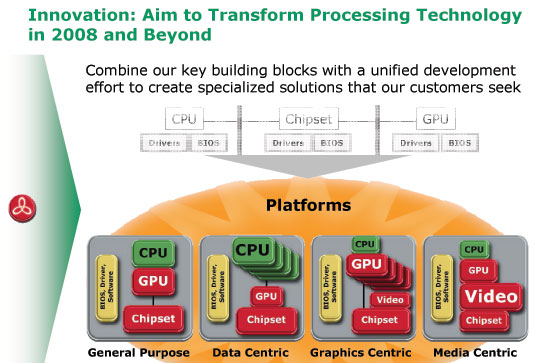AMD & ATI: The Acquisition from all Points of View
by Anand Lal Shimpi on August 1, 2006 10:26 PM EST- Posted in
- CPUs
Our Thoughts
Obviously each of the four companies we talked about today had their own take on the merger and no one here can really predict where things will go. On the one extreme, this deal could completely change everything; the combination of AMD and ATI could result in a powerhouse finally able to really compete with Intel while at the same time taking serious market share away from NVIDIA. On the other extreme, the combination could be a mess, resulting in a bloated company that is not much better off than before, with Intel and NVIDIA standing to reap the greatest rewards. It's far too early to tell and with the deal not even closed yet, there's no sense in counting any chickens.
That being said, there are some points we feel are worth discussing, and some analysis that can help give perspective to the whole merger. A lot of what we've presented so far is the company line from the four major CPU/Chipset manufacturers, and clearly there is going to be some bias in how each views the situation. It's far too easy to look at only one side of this story, so the following is designed to help examine the pros and cons of a handful of the facets of this merger.
Integrated Graphics is about to get Better
There's one definite outcome from the AMD/ATI deal, and that is an increase in the quality of integrated graphics. Currently, Intel is relatively unchallenged when it comes to integrated graphics solutions; independent GPU manufacturers like ATI and NVIDIA offer better integrated graphics solutions, but at much higher prices to keep their margins high. If AMD acquires ATI, we could in theory see an AMD platform with integrated graphics that would significantly outperform a similarly priced integrated Intel platform - hopefully this will force Intel to improve its integrated graphics.
Taking things one step further: if AMD puts a small ATI graphics core on-die or at least on-chip, the performance expectations for integrated graphics solutions would go up once more. Remember that one strength consoles have is the extremely low latency, high bandwidth interconnect between the CPU and GPU; a highly integrated CPU/GPU combo would be able to deliver that same performance advantage on a relatively low end PC.
Cool Stuff is Coming
On the investor call where AMD officially announced its plans to acquire ATI, a common theme discussed was AMD's Torrenza strategy. As AMD announced at its analyst day back in June, AMD plans on openly licensing its coherent HyperTransport bus allowing for companies like ATI or NVIDIA to develop GPUs and other co-processors that would plug into a Hyper Transport slot on a motherboard. The benefit is a very low latency, cache coherent interface between the CPU and any other device that it needs to feed large amounts of data to. With ATI operating under AMD's wing, AMD effectively guarantees that we'll see GPUs take advantage of Torrenza.











61 Comments
View All Comments
Thatguy97 - Friday, January 29, 2016 - link
Well that went to shit